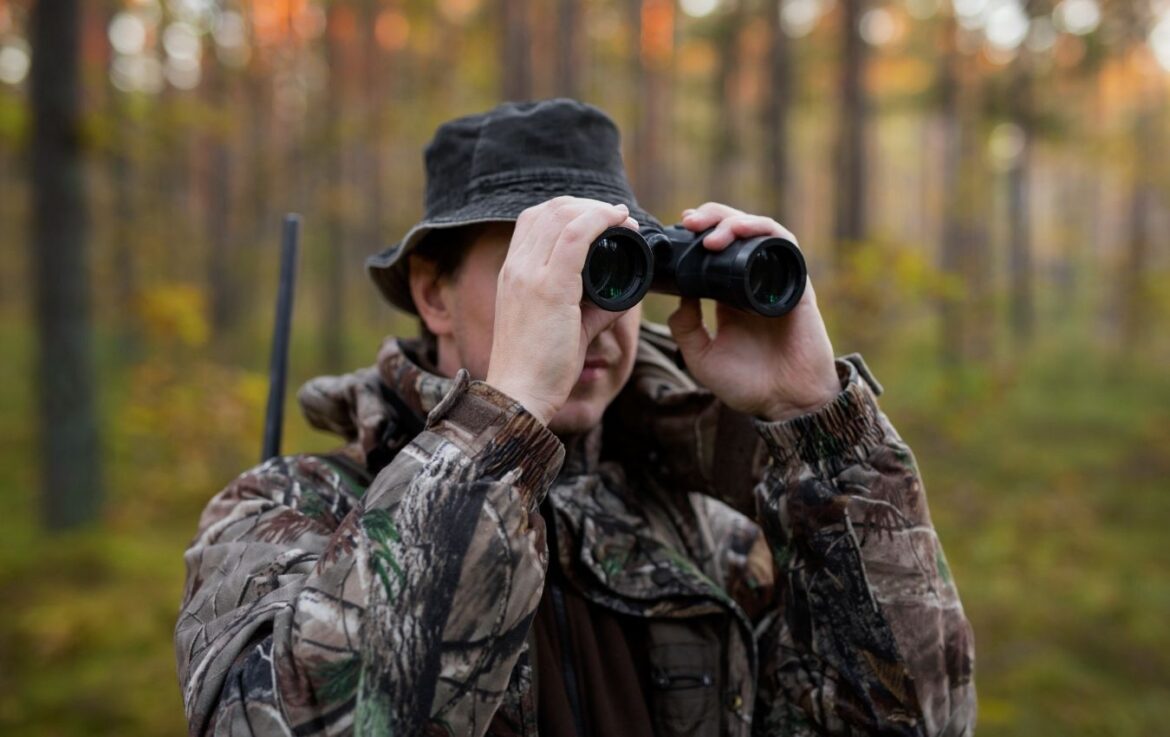Table of Contents
Fancy doing a spot of birdwatching or getting closer to the sporting action?
This is our pick of the finest binoculars you can buy
Apart from birdwatching, there probably isn’t many instances you can think of that require a pair of binoculars.
But there are many more (legal) use cases than you think. Going to the races for the day?
They’ll come in handy if you want to watch the horse you backed make it across the finish line.
A good pair can greatly enhance your enjoyment of the great outdoors; a bad pair can put you off for life.
But how do you tell the difference? And are cheap binoculars always a bad move?
To help you make the right decision, we’ve put together a list of the best binoculars you can buy.
And if you don’t know your objective lenses from your Porro prisms, then scroll down the page to get the full lowdown on what features you should be looking for in our handy buying guide.
The Best Binoculars to Buy in 2021
1. Nikon 8245 ACULON A211 8×42: The best binoculars under $100

The Nikon 8245 ACULON A211 is a small, lightweight binocular that packs all the features you’d expect from this popular company. It weighs only 2 pounds, so it’s easy to carry around for lengthy periods of time or use in uneven terrain like forest trails without being too heavy on your hands.
The rubberized coating makes holding these optics even better when put up against high humidity conditions because they will never slip out of grasps! Additionally, with an 8x magnification + 42mm lens size combo, it has more than enough field view at a lower cost compared to other brands within its range, which typically offer 5x magnification and an even smaller 28mm lens.
These budget binoculars are a great purchase for people who want to get their hands on some quality equipment without breaking the bank. They come equipped with adjustable eyepieces, which allow you to change settings while in use. There’s no exposed plastic or rubberized coating, so they feel like more expensive models!
With these excellent specs at such an affordable price point, we think this product is perfect if looking into purchasing new pair of glasses as well since it’ll be easier than trying to find something that fits your needs elsewhere online, where prices can sometimes be jacked up.
Key specs – 8x magnification; 42mm objective lenses; 8° field of view; 12 mm eye relief; adjustable eyecups; 16.4 ft (claimed) close focusing distance; 26.8 oz (with strap and lens caps).
More: Best Camping Gear
2. Opticron Discovery WP PC 8 x 42: Optically, the best binoculars under $300

These short, stubby Opticrons may not look particularly exceptional. Still, if you want the very best in optical quality for not much cash, they’re a good shout.
Technically, they’re slightly better quality than the Celestron Trailseeker 8 x 42 and present a sharper, clearer image that’s more neutrally colored.
They focus 2 feet closer – as close as 5 feet – which means they’re excellent for getting up close and personal with butterflies and bees.
They’re cheaper, too, than the Trailseekers and feel better made, with a smoother focus dial and longer 22mm eye relief, so they’re better for glasses wearers.
However, we’re not too keen on the cheap-feeling lens caps.
Where these Opticrons fall slightly short is in what’s included, or rather not included, in the box. All you get is a basic pouch and a simple, non-padded strap.
The Celestron’s include a stretchy neoprene strap, a pouch with extra compartments, and a harness.
Still, suppose the best quality image is important to you. In that case, they’re fantastic for the money and represent a big step up from the cheaper Olympus 10 x 25 and RSPB Puffin 8 x 32 models.
Key specs – 8x magnification, 42mm objective lenses, 7.5° field of view, 22mm eye relief, adjustable eyecups, 5 feet close focusing distance, 1.9 pounds (with strap and lens caps)
More: Best Hiking Backpacks
3. Swarovski EL 8.5 x 42: The best binoculars money can buy
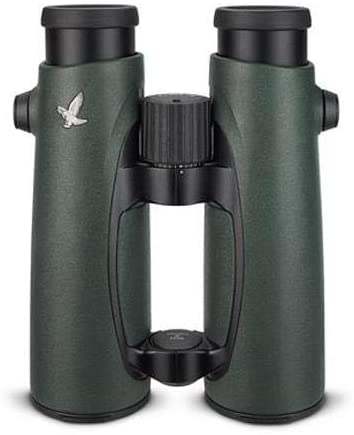
Question: What does £1,800 get you in a pair of binoculars?
Answer: The best image quality on the planet. That’s no understatement.
If you’re serious about your bird-spotting and money is no object, these Austrian-made Swarovski EL 8.5 x 42 are for you.
They’re so bright and clear that looking through them feels like an exercise in biological enhancement.
In low light, they’re so good they almost feel that they’re brightening the image; in good light, what you see is so sharp and clear you’ll forget you’re peering through binoculars at all.
Optically, they’re beyond reproach, with exceptional sharpness across a wide 7.6° field of view and no discernible chromatic aberrations.
They offer a touch more magnification than most of the binoculars we’ve used at 8.5x. Yet, they’re not at all difficult to hold steady and close focus is superb: you can peer at subjects from 5 feet.
Focusing is incredibly easy on the finger, too. The focus wheel is both light and smooth and super accurate.
The EL 8.5 x 42 are also highly practical and incredibly well-made. The eyecups feel solidly constructed and extend out in three notched stages (eye-relief is an extra-long 20mm).
The stretchy padded strap included in the box attaches via quick release clips to the side of each barrel, allowing for the quick attachment of other accessories.
Strap length adjustments can be made quickly. By simply rotating a dial on each strap to release and spinning it back the other way to lock the strap in position once you’ve made your adjustments.
Dioptre adjustment is super easy. Made not by grasping a ring on the right eyepieces but by flicking the focus wheel up, adjusting to your eyes, and flicking it back down to lock it in.
Naturally, these binoculars are solidly built and waterproof to a depth of 4m.
The Swarovski EL 8.5 x 42 are truly exceptional binoculars. They’re not cheap, but if you do have the money and nature watching is your passion, you will most certainly not be disappointed. They’re simply magnificent.
Key specs – 8.5x magnification; 42mm objective lenses; 7.6° field of view; 20mm eye relief; adjustable cups; 5 feet close focusing distance; 4.24 pounds (with strap and lens caps)
More: Best Hiking Boots
4. Canon 12 x 36 IS III: The best binoculars with image stabilization

Image stabilization isn’t just for cameras. Canon has also built its shaky hands reduction tech into its binoculars range, and it works incredibly well.
Pop a pair of AA batteries into a compartment on the Canon 12 x 3 IS III’s belly, press a small button on the top. Like magic, all handshake disappears, leaving you with a crystal clear, super steady image.
Normally we wouldn’t recommend using a pair of 12x magnification binoculars without a tripod. Still, with stabilization, these work just fine, and optically the Canons are splendid.
They present a sharp, bright image right out to the very edge of your field of view with neutral color representation.
There are some downsides, though. The high magnification level means the field of view isn’t particularly broad. At just 5°, you’ll spot less than you would with a pair of the much cheaper Celestron Trailseekers.
These aren’t quite as bright to look through as binoculars much cheaper, plus there’s visible color fringing around objects set against bright backgrounds.
They don’t focus particularly closely, either, so they’re not great for peeking at insects and flowers. And eye-relief isn’t very long at 14.5mm. Glasses wearers beware.
And we’re a little disappointed with the accessories supplied in the box. The strap isn’t padded. Bizarrely, you don’t get lens caps for the objective lenses. And also, the rubber, non-adjustable, roll-down eyecups won’t be to everyone’s taste either.
Even the ocular lens caps aren’t tethered. However, for that stupendously good image stabilization, we’re willing to forgive a lot.
Key specs – 12x magnification; 36mm objective lenses; 5° field of view; 14.5mm eye relief; non-adjustable eyecups; 20 feet closest focusing distance; image stabilization; 1.46 pounds (with strap and 3 x AA batteries)
More: The Best DSLR Cameras
5. Celestron Trailseeker 8 x 42: The best binoculars under $250

The best all-rounders in the binocular business are light, practical, and offer up a bright, sharp image with a wide field of view.
The Celestron Trailseeker 8 x 42 delivers on all these fronts. The field of view is an impressive 8.12°.
The “phase-coated” optics deliver a crisp image (although it does soften a little at the edges of the field of view). Also, the close focussing is an impressive 6.5 feet, so you’ll be able to observe insects and flowers close up as well as our feathered friends.
Despite this and a comparatively reasonable price, the Trailseekers are well-designed and well-built. They come with a generous selection of extras.
The tough-feeling green rubber housing is fully waterproof. The eyecups are adjustable in three stages, with eye-relief stretching all the way out to 17mm.
However, what’s most impressive is the range of accessories on offer here. The neoprene-padded strap, high-quality carry bag, lens cleaning cloth, and even a shoulder harness all supplied in the box.
Key specs – 8x magnification; 42mm objective lenses; 8.12° field of view; 17mm eye relief; adjustable eyecups; 6.5 feet close focusing distance; 1.45 pounds (with strap and lens caps)
Olympus 10 x 25 PC I: The best compact binoculars for close-up spotting

Compact binoculars are great to keep in the car or take on a trip when you’re traveling light, and the Olympus 10 x 25 PC I are some of the best around.
They weigh a mere 9.9 ounces, even with the lightweight neck strap attached and fold up small enough to fit in a jacket hip pocket.
Despite this, the high 10x magnification and narrow 25mm objective lenses, image quality is exceptional – sharp and much brighter than you might expect.
They’re well built, too, with a smooth focus ring, twist-out cups with 15mm of eye relief, and close focus that lets you get nearer to your subject than most other binoculars.
It’s advertised at 8.2 feet, but we were able to focus at around 5.6 feet. Coupled with the 10x magnification, this makes them excellent for insect and plant spotting.
The downsides of that extra magnification are that the field of view isn’t very wide – a mere 5.2° – they can be tricky to hold steady. The price is a little on the high side, but we love these compact binoculars. They’re superb.
Key specs – 10x magnification; 25mm objective lenses; 5.2° field of view; 15mm eye relief; adjustable cups; 5.6 feet close focusing distance; 9.9 ounces (with strap and lens caps)
More: The Best Camera Tripods
How to buy the best binoculars for you
To look at, one pair of binoculars would appear to be much the same as another. Some might be smaller than others. By and large, they’re made up of a pair of barrels with lenses at either end, attached to each other with a hinge in the middle.
Dig deeper, however, and you’ll discover there’s a whole world of features and specifications that determine how good a pair of binoculars are and the sort of spotting activities they’re suited to.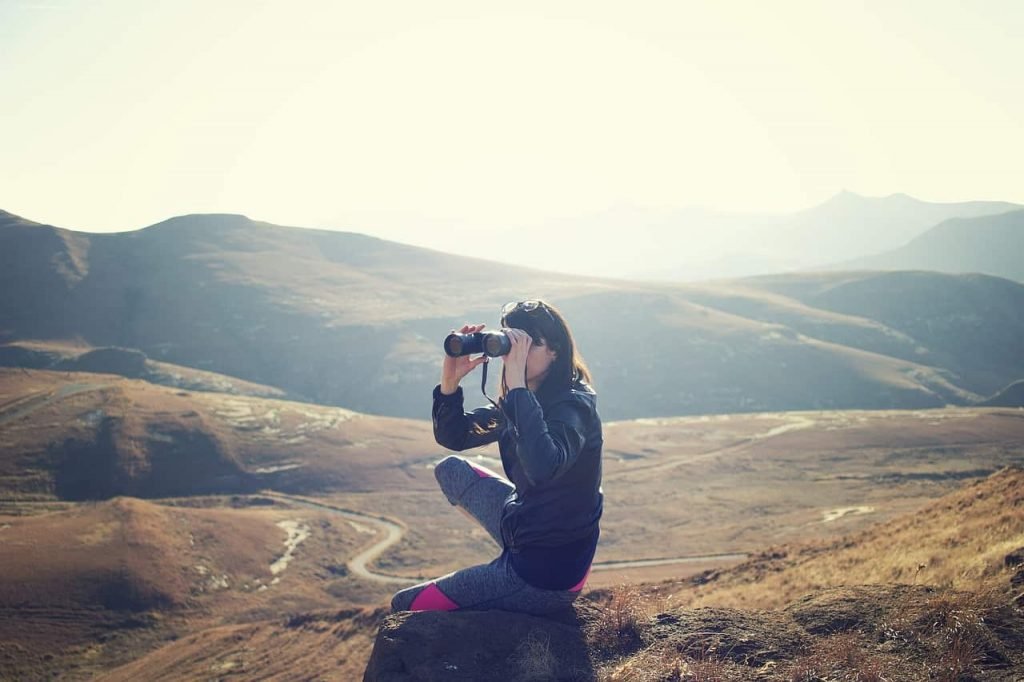
What type of binoculars should I buy?
You’ll probably have noticed if you’ve ever looked for or used a pair of binoculars that they all have a pair of numbers – like 8 x 42 or 10 x 25 – written somewhere on them.
The 1st number on them designates the magnification level. So, an 8x pair will enlarge your subject eight times, while a 10x pair will make it ten times bigger.
The 2nd number tells you how large the objective lenses (the big ones on the end) are in millimeters.
The most important number is the magnification level. You might think here that bigger is better, right?
Well, that’s not strictly true. While a 10x or 12x magnification will allow you to see things further away that bit closer, higher magnification such as this has knock-on effects.
At higher levels of magnification, it’s usually hard to hold binoculars steady enough to see a stable image. Higher magnification also usually means a narrower field of view.
Field of view (or FOV), is another figure usually stenciled on the binocular somewhere. It refers to how much you can see from left to right when you’re peering through them and it’s normally expressed in degrees.
What is the best magnification level for bird watching?
The sweet spot for birdwatching and nature-spotting binoculars is 8x. This gives you a reasonably broad field of view (around 7 to 8 degrees) and magnification and allows you to hand-hold easily without getting too much distracting shake.
Suppose you’re more of a stargazer and need binoculars for looking at the moon and constellations. In that case, you’ll want a higher magnification level – 12x and up – but you’ll need to think about attaching them to a tripod.
What benefit is there to buying binoculars with bigger lenses?
The objective lens size is most critical to the quality of the image you see through your binoculars.
The larger the lens, the greater its light-gathering ability is. Too small, and the image will be murky and dim; too big, though, and the binoculars will be too bulky and heavy to be practical.
That’s why in this test, we’ve mostly focused on binoculars with 42mm objective lenses (and why most manufacturers do the same) because they strike the best balance between light gathering and practicality.
If you want pocketable binoculars, choose a pair with 25mm lenses or 32mm.
If you’re mostly going to be stargazing or mounting your binoculars to a tripod. In that case, you can get away with larger lenses.
In summary, then, an 8 x 42 pair of binoculars 8x magnify a scene and has 42mm lenses; a 10 x 25 pair has 10x magnification and 25mm lenses.
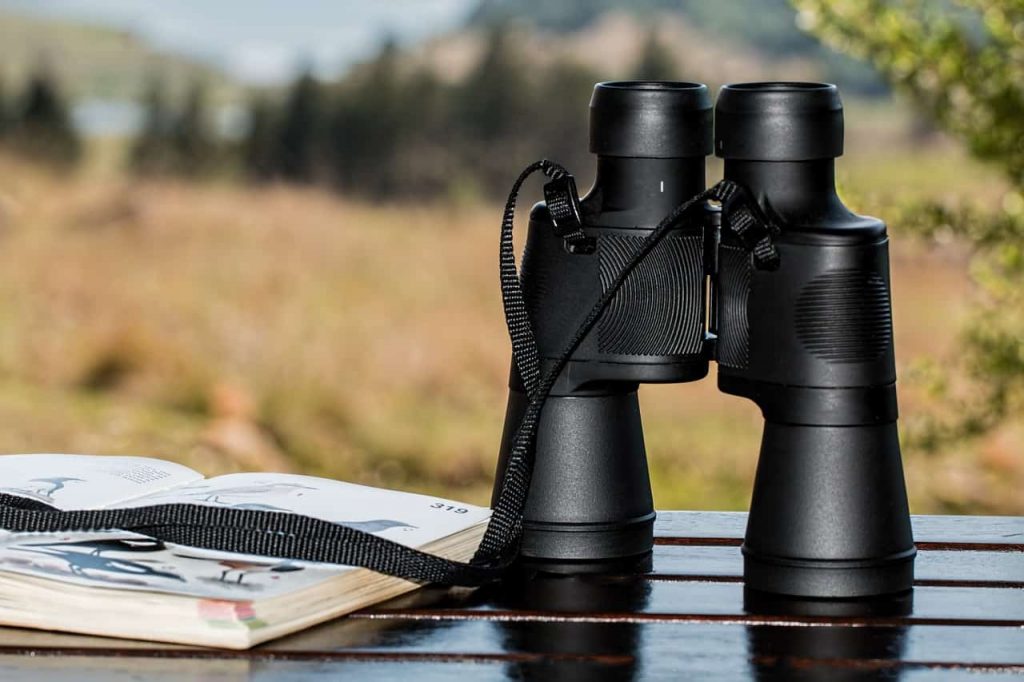
Should I care about features such as prism types or ED glass?
You might hear the other terms connected with binoculars and see on specifications sheets are Porro prism, roof prism, and ED glass.
Porro and roof prisms: All binoculars use prisms to keep the size down. Otherwise, they’d all be huge and look like a pair of telescopes strapped together.
Prisms come in different flavors, though, and the type of prisms used dictates the shape and size of your binoculars.
Traditional A-shaped binoculars use Porro prisms. Porro prism binoculars tend to be larger and bulkier than roof-prism binoculars but slightly cheaper.
More modern H-shaped binoculars use roof prisms. These are the most popular type in use today because they tend to be smaller and lighter than Porro-prism optics.
ED or HD glass: ED (extra-low dispersion) glass (also referred to as HD glass by some manufacturers) is a special type of glass that’s designed to keep chromatic aberrations under control.
You can spot chromatic aberrations by looking at a dark object silhouetted against a bright background – a kestrel against the sky, for example. It manifests as color fringing around those objects.
Binoculars with ED or HD glass tend to keep such fringing to a minimum, and the image you see through them will be clearer and sharper as a result.
However, ED glass is more expensive than standard glass, so you’ll tend to see it only in more expensive binoculars of above £200.
The other key features to look out for
Close focus: Great for spotting insects and inspecting flowers from close range. The best binoculars let you focus from as close as 1.5m away.
Waterproofing: You’re going to be using your binoculars outside, so it’s best to be sure that they won’t let in if you’re caught in a rain shower. They’ll fog up, and condensation will form on the inner surfaces if this happens.
Fog proofing: To prevent binoculars from fogging up when transitioning from the cold outdoors to the warm indoors, manufacturers fill their binoculars with an inert gas (usually argon or nitrogen) with no water content and thus inhibits condensation.
Eye relief: If you wear spectacles, binoculars with long eye relief and adjustable eyecups will make it much easier for you to see the full field of view while wearing your glasses.
Look for binoculars with an eye relief of 14mm or longer. The more, the better, though, as this will give you more opportunities to tweak for the best view.
When it comes to finding the best binoculars, there are a few considerations that you must make. One of the most important things that you have to take into consideration is lighting. If you are using your binoculars at night, you obviously need to make sure that the pair you buy is waterproof. To see clearly at night, even with the best quality binoculars, you must be able to use them in the dark.
The best binoculars available for astronomy will be very different from the best binoculars available for bird-hunting, stargazing, or horseback riding. If you are new to this hobby and are not sure what type to purchase, we have rounded up what you should know to quickly find the best binoculars available for beginners like you. First, you must understand that there are basically three types of binos: solid-state binos, gas-cooled links, and solar binos. All of these come in one basic design, but there are a few different variations that you can take advantage of.
Frequently Asked Questions
Why do I need binoculars?
There might not be many instances you can think of that require a pair of binos, but there are many more legal uses. Any time you want to watch something from far away – sporting events being one example – it’s worth having a look through some bins. You can also get closer to the action when birdwatching – the sky’s not the limit with a pair of binoculars.
What are manufacturers using to make bins?
Each model is different, but most binoculars are constructed from magnesium fluoride, which doesn’t rust, making it perfect for damp conditions. We’ve tested many waterproof models that have stood up to being dropped in water and fogging up on us without fail.
Bin lenses come in two types: porro-prism or roof-prism. Porro-prisms tend to offer better value, while roof prisms are generally considered more technically advanced because they’re marginally smaller, lighter, and easier to hold steady. This makes them great for long-distance viewing at the cost of being bigger, heavier, and pricier.
What are my options when it comes to size?
You’re spoiled for choice! There are kids’ bins, pocket/mini pairs which can be carted around in your handbag or pocket, mid-range compact models that are easy to transport but won’t break the bank, full-sized standard bodies that provide a crystal clear image without too much of a compromise on portability, through to large ‘gigantic’ monster versions with over 50mm lenses – perfect if you want the best view but don’t mind paying for it. You’ll have no problem finding one that fits your requirements.
If there’s more than one pair you’re considering purchasing, take them out into the field and test ’em out – you’ll know which one’s right for you in no time.
What is the best magnification for binoculars?
8x magnification is considered standard, which gives you an upright image and a wide field of view, ideal for general use and birdwatching. 10x and 12x magnifications offer better detail at the cost of a narrow field of view – perfect if you’re after something that offers more magnification without sacrificing too much on your peripheral vision.
Do I need to buy expensive lenses?
We wouldn’t recommend it as they can make binoculars significantly heavier. We’ve tried many excellent models that don’t cost the earth yet still boast great glass – even those from ‘budget’ brands can be excellent value for money! That said, if you’d like peace of mind, opt for premium-priced glass – those with a quality score of 8 or 9/10 should do the job.
Which is better: 8×42 or 10×42 binoculars?
It all comes down to the level of magnification and objective lens. At 8x power, you’ll have a wide field of view which is great for scanning the horizon as well as being able to see distant subjects clearly. With 10x magnification, things will appear closer. Still, objects won’t be as big in the frame. For this reason, it’s often better suited to birdwatching or observing creatures where you want to closely examine their features without them being too far away.
What is a roof prism?
These are slimmer, more compact, and easy to hold steady. Standard porro-prisms tend to be bulkier and less stable when you have them up against your face – often, the light gets in too. Roof prism models can also be made from high-quality BaK-4 glass, which offers better clarity, contrast, and brightness than standard BK-7 glass for a slightly higher price tag.
What is maximum eye relief?
This is the distance from your eyes that allows for a full field of view, which also ensures you’re not too close to the eyepiece and risk added strain on your eyes. You can measure this by holding up the binoculars at arm’s length. If you read about a pair having 15mm or 20mm eye relief, it means they should be comfortable to use even if you wear glasses.
What makes a good birdwatching binocular?
The magnification of a pair is the only thing relevant to birdwatching. Anything with over 8x power will be fine, and anything higher than that (up to about 20x or 30x) will yield even more clarity when you’re observing feathered friends in close quarters.
As long as your chosen model boasts HD lenses and has great anti-glare properties designed for use in low light conditions (such as dawn and dusk), you should be set for spotting avians in any weather condition – we’d recommend glass made from BaK-4 glass, which is clearer and sharper than standard BK-7 glass.
What are BAK-4 glass lenses?
BAK-4 is actually just another name for high-quality BaK-4 glass, which has better clarity, contrast, and brightness than standard BK-7 glass. It’s most often used in roof prism binoculars, but it can also be found in porro prisms.
How do I store my binoculars?
It’s important to keep them somewhere safe with plenty of padding, so they don’t break or get scratched. If you’re lucky enough to have a fitted case with somewhere safe to store them, that’s ideal – but if not, then an old pillowcase will do the trick!
Young people are often more likely to damage their possessions through rough treatment. They’re also more lenient on the budget, which means they risk purchasing lower quality, cheap models that won’t last long. So parents may want to take note of this when buying their child new binoculars as a gift.
How do I clean binocular lenses?
The easiest way is to use a cloth – but make sure not to scrub them as this can leave tiny scratches. Use clean, lukewarm water and an ordinary lens cleaning fluid (which you should be able to pick up from any camera or optics store) – apply small amounts to the cloth, never directly onto the lens. Don’t wipe too hard because it will scratch! It’s best to keep your equipment in a case when you’re not using it, especially if traveling abroad with them – that prevents any knocks or damage that may occur when in transit.
Conclusion
Finding the best binoculars is a worthwhile pursuit, as the right pair can make all the difference. Whether you’re a die-hard birdwatcher, sports fan, or adventurer who likes to watch the wildlife as you hike, there’s a pair for you. Our top pick is the Nikon 8245 ACULON A211 8×42, which offers excellent value and quality.
The best binoculars for you will depend on your budget, which is why we’ve got price recommendations for what to expect to pay at different levels.
